|
GREATER LONDON |
| CITY OF
WESTMINSTER - 2 |
|
| <City of London
I> <City
of London II> <City of London III> <City of Westminster-1> <City
of Westminster-3> <City of
Westminster - 4> <Borough
of Kensington & Chelsea> <Borough of
Wandsworth> |
|
|
|
|
| |
Chapel of St Edmund & St Thomas
(St Edmund was king of East Anglia
and the St Thomas is Thomas Becket) |
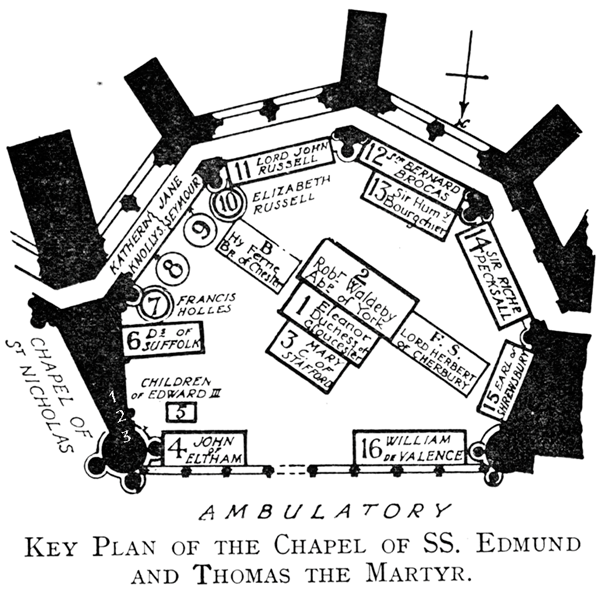
 |
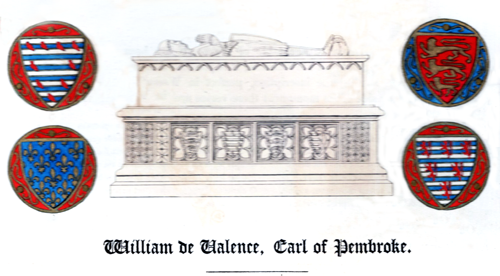
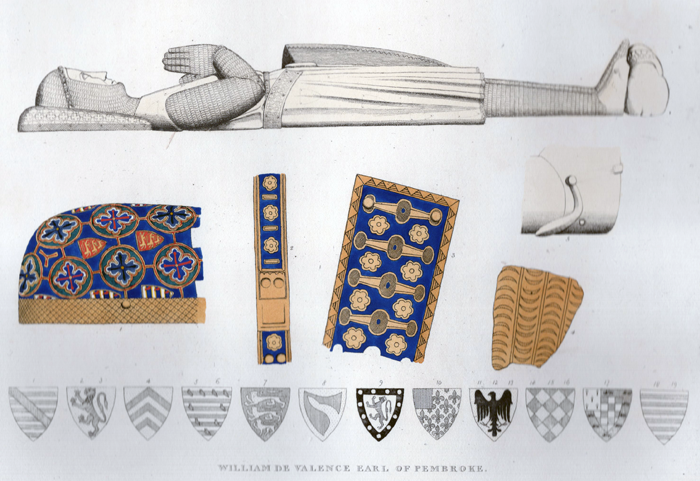
|
 |
16)
William de William de Valence, Earl of Pembroke (1296)
The tomb is the only English example of
Limoges champlevé enamel work. The effigy and tomb chest are of
oak and once were both covered by enamelled copper plates,
mostly now lost from the chest (save five shields)although
thankfully not from the effigy. There are also a number of
shields on the stone base of the monument. |
He was the son of
Isabelle of Angoulême, King John's widow, and her second husband
Hugh X of Lusignon, Count of Marche , and hence half brother to King Henry III.
In addition to his French holdings, he aquired vast estates in
England and Ireland by his marriage to Joan, who was co-heir of
the Marshals, Earl of Pembroke. |
|
 |

 |
| 4) John of Eltham, Earl of Cornwall (1336) was the
second
son of Edward II and was three times regent when
his brother
Edward III was absent from the kingdom,
although, dying at nineteen, he was a teenager. Alabaster effigy
and tomb chest,
probably by the same artist who made Edward II's
effigy in Gloucester Cathedral. Note the weepers around the tomb chest
in the top tier of canopies, those on the north side being
better preserved.
The lower tier contains shields. The canopy was broken in 1776 and unfortunately
removed. |
|
 |

|
 |
5) William of Windsor (1348) & Blanche of
the Tower (1342)
Children of King Edward III. William died from the
plaque at three months and Blanche also died young. They are,
however, represented as children rather than babies in these
effigies, as is curiously often the case.
See also William of Hatfield in York Minster.
Purbeck marble tomb chest with alabaster
effigies
by John Orchard of London. A brass is lost from the
ledge as well as small figures within the upper row of the two
tiers of panels of the tomb chest.
|
|
 |
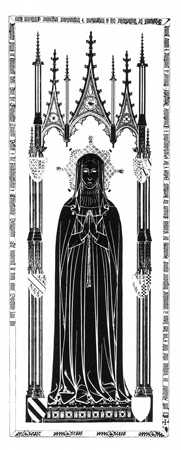 |
 |
2) Robert de Waldeby or Waldby (1397),
Archbishop of York, was an Augustinian Friar and a friend of the
Black Prince. This fine brass was raised on a low dias in the
late 19th century. |
1) Eleanor de Bohun, Duchess of Gloucester (1399)
was the wife of Thomas of Woodstock,
Duke of Gloucester, who was murdered on the orders of his nephew King
Richard II in 1397. She was sister to Mary de Bohum,
first wife of Henry Bolingbroke, who later (and after her death)
became Henry IV. Fine brass on a low Pubeck marble tomb chest. |
13) Sir Humphrey Bougchier (1471) was killed at the Battle of Barnet
fighting for Edward IV. The brass effigy on the low Purbeck
marble table tomb is lost but the helm
and shields remain. On low tomb chest. |
|
|
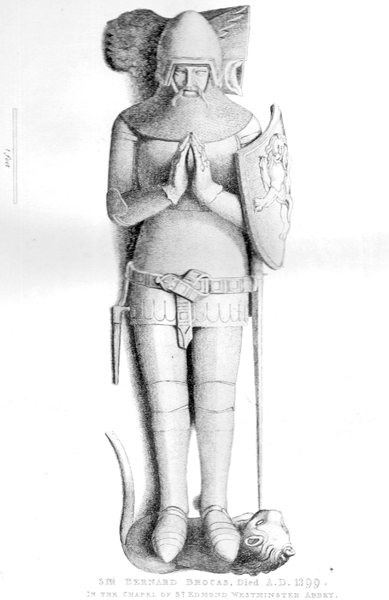 |
 |
12) Sir
Bernard Brocas (1395)
He was the father of another Sir Bernard who was
executed in 1400 for conspiring against Henry IV and attempting
to restored Richard II to the throne.
A recessed altar tomb, with six quatrefoiled each with blank
shield, with effigy and canopy. The effigy is of 'doubtful
antiquity' (RCHM); the unlikely shield shown in the Stothard
etching is now gone. The inscription above the effigy is of the
eighteenth century and not correct, but the brass inscription on
the edge of the tomb is original. All restored in the eighteenth
century. |
|
|
Other Monuments |
| |
|
| 3. |
Mary, Countess of Stafford (1694)
She was created Countess of Stafford in her own right eight
years after her husband's attainder for treason in 1680. Low
tomb chest of white marble with moulded top slab |
| 6. |
Frances, Duchess of Suffolk (1559)
was the daughter of Charles Brandon, Duke of Suffolk,
who had married Mary, daughter of Henry VIII and widow of
French King Louis XII. Frances married Henry Grey, 3rd Marquis
of Dorset, who became Duke of Suffolk. Duchess Frances and Duke
Henry became the parents of Lady Jane Grey, the Nine Day Queen.
Lady Jane and her father Duke Henry were executed by Queen Mary
I in 1551. Frances lived in poverty during the rein of 'Bloody
Mary' but married, in 1557 (two years before she died) her groom
of the chamber (Adrian Stokes) who erected this monument to her
.
The effigy is of alabaster; the tomb chest has fluted Tuscan
columns at the angles supporting an entablature, on which the
slab of the tomb chest. The sides are divided into three bays,
separated by pilasters, of which the middle bay contains an
inscription and the outer bays - and the west end - display
cartouches of arms. The effigy lies on a rolled rush mat with
lion at the feet and lion at the feet. She wears a coronet
and French cap. |
| |
Nearby is buried Lady Cumberland,
Margaret, Countess of Derby (1596) but there appears to
be no monument. She was the sister of Duchess Frances (above)
She was accused of witchcraft and imprisoned by her cousin,
Queen Elizabeth I in 1590; when released she was forbidden to
approach the court or live with her husband. |
| 7. |
Francis Holles (1622)
He died at eighteen. Alabaster seated figure in Roman armour on
a circular stone pedestal. By Nicholas Stone |
| 8. |
Katherin Knollys (Caree) (1569)
Sister of Lord Hunsdon and hence neice of Queen Anne
Bolyn. Wife of Sir Thomas Knyollys. Wall monument of marble
flanked by Corinthian pillars supporting an entablature with a
broken pediment and cartouche-of-arms. |
| 9. |
Jane Seymour (1560) She was
the daughter of the Protector Somerset (Edward Seymour, brother
of Queen Jane Seymour) and so cousin to Edward VI.
She died aged nineteen. Wall monument in marble,
flanked by two Corinthian pillars supporting an entablature with
two crests and cartouche-of-arms on the cornice. |
| 10. |
Elizabeth Russell (1601)
Daughter of 11. Monument of black and white marbles. She sits
upright, foot on a skull, in a basket weave chair on a
decorated pedestal. |
| 11. |
Lord John Russell (1584)
was son of the second Duke of Bedford. Sarcophagus and wall
monument of various marbles. He reclines on his left elbow and
his infant son, Francis, lies at his feet.
Flanking the sarcophagus are two Corinthian pillars which
support an entablature with cartouches of arms. The inscription
is in Latin, English and Greek. |
| 14. |
Sir Richard Pecksall (1571)
and his two wives, Eleanor (Pawlett) and
Eleanor (Cottgrave). Large marble wall monument
with three arched recesses. His effigy, in armour, kneels
between those of his two wives, each in their separate recesses.
There are four small kneeling figures of his daughters by his
first wife; they stand in a lower stage below their father. |
| 15. |
Edward Talbot, 8th Earl of
Shrewsbury (1618) & Countess Joan (Ogle) (1626) A
Jacobean monument of various marbles with two recumbent effigies
but with a kneeling effigy of their daughter by her
father. The iron grill (by William Wright) is lost. The
elaborate sarcophagus is surmounted by touch stone slab,
supported by three ionic columns, on which lie the effigies, he
in armour. The monument has a canopy of a high round arch.
Several shields of arms. The monument was erected by the
Countess. |
| FS |
Edward Herbert, Lord Herbert of
Cherbury (1678) Floor slab |
| B |
Henry Ferne , Bishop of Chester
(1662) Blue floor slab with brass |
Wall Monuments
These wall monuments are labelled in
the wall numbered 1, 2, 3 above the monument to Willaim
Blanche, children of Edward III |
| 1. |
John Paul Howard, Earl of Stafford
(1762) Grandson of 3. Tablet |
| 2. |
Nicholas Monck, Bishop of Hereford
(1661) Brother of double turncoast General George Monk.
By W. Woodman and errected by the Bishop's grandson in
1723 |
| 3. |
Henry Howard, Earl of Stafford
(1719) |
| Monuments not shown on Plan |
| A |
Edward Buller-Lytton, First Baron
Lytton (1873) Author of The Last Days of Pompeii and many other novels.
Floor slab in front of 10 and 11. |
| B |
Sir Fresheville Holles (1672)
Naval hero, killed at Sole Bay. Unknown. |
|
|
|
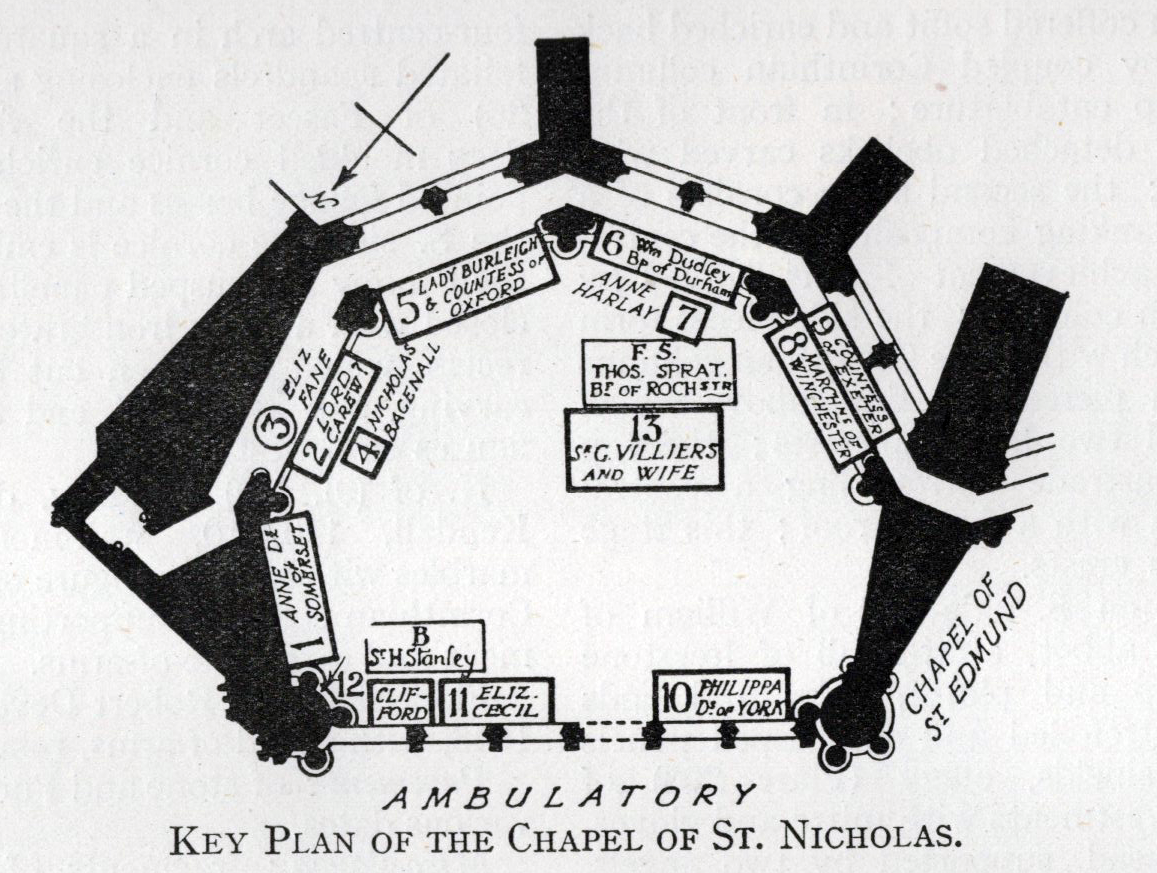
|
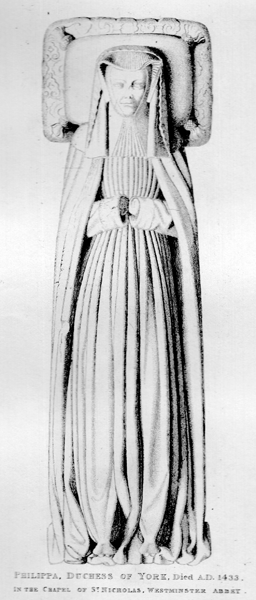 |
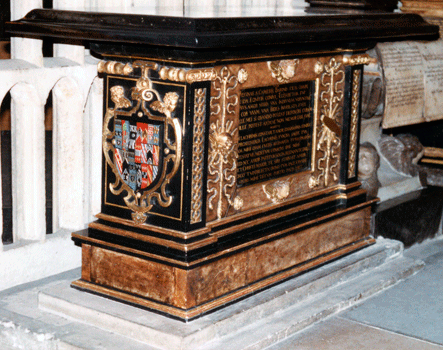
11) Elizabeth Cecil Wife of Sir Robert Cecil, son of
William Cecil, Lord Burghley. Alabaster tomb with black marble
slab, erected by her husband. |

10) Left & above:
Philippa, Duchess of York (1433)
Philippa Mohun married as her third husband Edmund, 2nd
Duke of York, son of Edmund of Langley, 1st Duke, who himself
was son of King Edward III. Edmund was killed at the Battle of
Agincourt and Philippa retained the Lordship of the Isle of
Wight, which had been granted to her husband.
This was the earliest burial in the chapel |
|
|
|
|
Other Monuments |
| 1. |
Anne (Stanhope), Duchess of Somerset (1587)
Widow of Edward, Duke of Somerset, the Lord
Protector, and hence sister-in-law to
Queen Jane Seymour and Aunt of Edward VI. Large monument
of various coloured marble. Alabaster recumbent
effigy, wearing a coronet and French cap, lying on sarcophagus, underneath a recessed arch with
decorated soffit. The sarcophagus rests on a paneled plinth. Two further upper stages with arms,
obelisks etc on the lower and a top stages with further obelisks
and a castle with a lion atop holding a fireball. (the Stanhope
arms) |
| 2. |
Nicholas Carew, Baron Carew (1470)
and Margaret (Dingham) (1470) A Purbeck
marble altar tomb; the brass and three shields have been lost. |
| 3. |
Lady Elizabeth Fane
(Spenser) (1618), wife of Sir George. Wall monument
of various coloured marbles with two full faced, kneeling figures
with a prayer desk between. Under a
canopy flanked by Corinthian pillars which support an
entablature with hanging curtains drawn back.. The
superstructure has a draped achievement of arms and a broken
pediment with a cartouche in the middle and two cherubs holding
a crested helmet. |
| 4. |
Nicholas Bagenhall (1688)
Died at two months. Rectangular marble monument consisting a
paneled pedestal with a cartouche-of-arms and a black pyramid
surmounted by an urn. * |
| 5 |
Mildred Cecil (Cooke), Lady Burghley
(1589) &
Ann,
Countess of Oxford (1588) Respectively the wife of
William, Cecil, Lord Burghley and their
daughter. On a sarcophagus their are effigies of the mother and
daughter and, on a tier above, a kneeling effigy of Lord
Burghley, who was buried at Stamford, Lincolnshire. An effigy of
the son, Robert Cecil, kneels at his mother's feet and her three
granddaughters, Elizabeth, Bridget and Susannah, at there feet.
24 feet high and of coloured marbles. |
| 6 |
William Dudley (or
Sutton), Bishop of Durham (1483) Previously Dean of
Windsor. The brass and inscription are lost. |
| 7. |
Anna Sophia Harlay (1605)
Infant daughter Christophe Harley, Count of Beaumont, French
ambassador. A pyramid with vase containing her heart. |
| 8. |
Winifred (Brydges), Marchioness of Winchester
(1586) Below her effigy figures of her children
by her first husband (Sir Richard Sackville) kneel: Thomas
Sackville, Lord Buckhurst (the poet) and Anne, Lady Dacre
(1595). Her second husband was John Paulet, 2nd Marquis of
Winchester |
| 9. |
Elizabeth Cecil, Countess of Exeter (1591)
Above 8. This is only part of a monument - with a reclining
figure - which was removed to make way for the Percy
(Northumberland) monument. She was wife of William Cecil
(afterwards Earl of Exeter) who was grandson of Lord Burghley.
She was Baroness Ros in her own right |
| 11. |
Elizabeth Cecil (1597)
Daughter of Lord Cobham and wife of Sir Robert Cecil
(afterwards 1st Earl of Salisbury) son of Lord Burghley.
Alabaster with black marble slab. |
| 11a. |
Lady Jane Clifford (1679)
Great granddaughter of Protector Somerset. Black marble with
alabaster heads of cherubs in the corners. By J
Bushnell. This is to the left of 11, labelled but not
numbered |
| 12. |
Isabella
Suannah, Countess of Beverley (1812) Wall monument by
J Nollekens |
| 13. |
Sir George Villiers (1605)
and Mary (Beaumont)(1632) White marble altar
tomb with recumbent figures, by Nicholas Stone. Parents
of George, Duke of Buckingham |
| B. |
Sir Humphrey Stanley (1505)
Brass in Purbeck marble slab with man in armour; three shields
of arms with indents for two more shields. |
| FS |
Thomas Sprat, Bishop of Rochester |
| |
|
| Monuments not shown on
Plan |
| A |
Elizabeth, Duchess of Northumberland
(1776)
In her own right was Baroness Percy etc and heiress of
Earls of Northumberland; she married Sir Hugh Smithson who
took the name of Percy and was created Duke of Northumberland.
The crowd appeared to have rioted at her funeral and said to
have broken the canopy of the tomb of Jon of Eltham. Designed by
R Adam and executed by N Read. In the next bay to
that of 10 travelling anti-clockwise |
| |
|
|
|
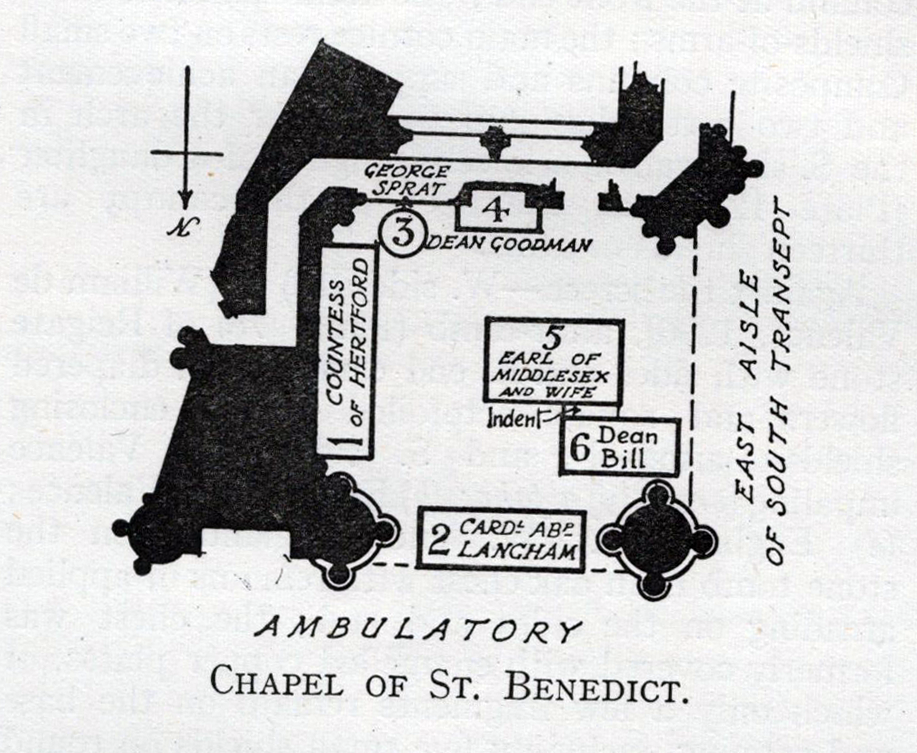 |
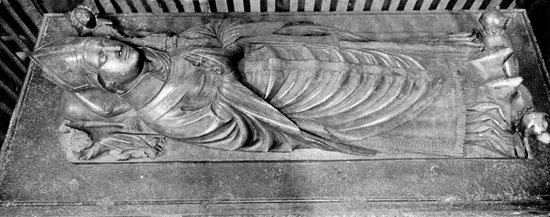 |
|
2. Cardinal Simon de Langham (1376)
Abbot of Westminster, later Chancellor of
England and still later Archbishop of
Canterbury. When he was made a cardinal he was
obliged to resign as archbishop and he joined the
Papal court. By Henry Yevele & Stephen Lote.
Alabaster effigy wearing mass vestments and
carrying crozier and pall; iron grid but the canopy was destroyed at the coronation of George I,
but much of the brass inscription remains. There
are a number of shields of arms in quatrefoils panels on the
tomb chest. |
|
Other Monuments |
| 1. |
Frances Seymour
(Howard), Countess of Hertford (1598)
Wife of Edward Seymour, Earl of Hertford, and sister to
Lord Howard of Effingham, the Lord High Admiral who defeated the
Spanish Amada. Combined wall monument and altar tomb of various
marbles. Paneled altar tomb supports the effigy, wearing a
French cap, which is of flanked by two group of three
Corinthian pillars. These pillars support an entablature and
above each group is pavilion summoned by an obelisk. The back
of the tomb has two tablets under arches springing from a
central column. Above is a large centre piece with arms flanked
by columns and surmounted by three obelisks. |
| 3. |
George Sprat (1683) Son of
Dr Thomas Sprat. Dean of Westminster. (see above) Wall monument
with three cherub heads, urn and blank shield of arms. |
| 4. |
Dr Gabriel Goodman
(1601) Dean of Westminster who addressed the House of
Commons supporting the rights of Sanctuary at Westminster; in
consequence they were supported in cases in debt only
(being suppressed in all other cases) until the reign of James I.
Wall monument with low plinth, with inscription, on which the
Dean in skull cap and robes kneels at a prayer desk. In
the wall at the back is a round arch with reset 13th century
shafts with moulded capitols and bases. There is a painted
shield of arms on the wall above the recess. |
| 5. |
Lionel Cranfield, 1st Earl of Middlesex
(1645) and his wife, Anne (Bret). He was Lord
High Treasurer under James I; impeached at the instigation of
the Duke of Buckingham, he was later pardoned. Large altar tomb
of touch and white marble with effigies. The tomb has paneled
sides with baluster shapes pilasters at the corners; arms at the
ends. He wears a coronet and a long fur robes with feet on an
antelope; she also wears a coronet, holds a book with her feet
resting on a griffin. Possibly by Nicholas Stone. |
| 6. |
William Bill (1561) First
Dean of Westminster after the Abbey was established as a
collegiate church by Elizabeth I in 1560. Low altar tomb with
brass figure with Latin epitaph; a brass around the edge of the
tomb is lost |
|
William de Curtlyngton (1333)
Abbot of Westminster. He was buried under the altar but
the brass and inscription are lost. Could this be the indent
under 5 and 6? |
| |
|
|
Burials with no Monuments |
| |
John Spottiswoode (1639)
Archbishop of St Andrews, Scotland |
| |
James Spottiswoode (1645)
Bishop of Chester. Younger brother of the above |
|
|
|

Above (north) is the Chapel of Edward the Confessor (partally shown)
and below (south) the chapels above (not shown)
FS is Floor Slab and B is brass
|
|
Monuments |
| 5. |
Robert Aiton Wall monument
of black and white marble by F. Fanelli. Oval recess
containing draped bronze bust, flanked by standing figures of
Apollo and Athena. Above is a curved pediment with two cherubs,
cartouche of arms and a bronze inscription plate. |
| 6. |
Sir Thomas Ingram PC,
Chancellor of the Duchy of Lancaster and his daughter
Mary (1651) Wall monument of stone and black and white
marble consisting of plinth, inscribed pedestal and urn flanked
by cherubs; inception panel at the top. |
| 7. |
Richard Tufton (1631)
Wall monument of black and white marble with oval recess
containing bust in armour. Flanking the recess are Ionic columns
supporting an architrave with reclining figures of Mercury and
Mars and a cartouche of arms. |
| 9. |
Katherine (1257) aged five
and four other children of Henry III; later in the same tomb
were buried four children of Edward I. Altar tomb of
Purbeck marble ( c. 1270) which was moved here from the
Confessor's chapel to make room for that of Richard II(c. 1394).
The front is of two bays, which had panels of marble,
flanked by pilasters which were formerly enriched with mosaic;
the sides were similar. The top slab has a series of circles of
marble or mosaic surrounded by interlacing bands of mosaic. Of
Cosmateque work. |
| |
|
| FS11. |
Dame Frances Apsley (1698) |
| FS12 |
Sir Allen Apsley (1683) |
| FS13. |
Sir Henry Spelman (1641)
Antiquary |
| FS14. |
Anne Apsley (1681) Wife of
Sir Peter |
| FS15 |
Allen Apsley (1691) |
| FS16. |
Sir Robert Anstruther (1645)
Privy Councellor |
| FS17. |
Philip Ludlow (1650) who
died at sea in Sephier, being in command
of the Brazeele merchant ships. |
| FS18 |
Lyonel Cranfield (1674)
with defaced shield of arms. |
| FS19. |
Anne Cranfield (1669-70) |
| |
|
| BIII. |
Thomas Bilson (1616) Bishop of
Winchester. Brass - inscription only. One of the translators of the King James
Bible. |
| BIV. |
Sir John Golofree (1369)
Fragments only and indents of two shields. Rest defaced.
Second husband of Philippa, Duchess of York. Large Purbeck
marble slab; the original brass fragments are preserved in the
Muniment Room. |
| |
|
| I-VII. |
Defaced but probably Robert Harowden
(1440) Abbot |
| I-VIII |
Of a figure, four shields and an
inscription. |
| I-IX |
Of a figure etc. (No further information) |
| I-X. |
Defaced; rivets remain. |
| I-XI |
Defaced; rivets remain. |
| I-XII |
Defaced but of a bracket brass with figure
and inscription. This may be that of Ralph Selby
(1420) A Westminster monk who was buried south of King
Sebert's tomb |
| |
|
|
Monuments not shown on Plan |
| |
Robert Tounson (1621) Dean
of Westminster then Bishop of Salisbury. Outside Chapel of
St Edmund but no details. |
| |
|
| Burials with no Monument |
|
Richard de
Berkyng Abbot of Westminster (1222-46) One of the
witnesses of Magna Carta who held a number of offices of state.
He was buried in the Old Lady Chapel and his remains were said
to have been moved here on its demolition but the site is
unknown |
| |
|
| There are a number (six) brass
indents, labelled VII to XII. Wall monuments are indicated by a
number within a circle |
| |
|
| In 1960 a bronze tablet,
designed by J S Comper was erected on the wall by King
Sebert's tomb to Queen Anne Neville (1485),
wife of Richard III and daughter of the 'Kingmaker'. She was
buried in front of the sedilia but there was no monument. |
|
|
|
|
|
<City of London
I> <City
of London II> <City of London III> <City of Westminster-1> <City
of Westminster-3> <City of
Westminster - 4> <Borough
of Kensington & Chelsea>
<Borough of
Wandsworth> |
| |






















